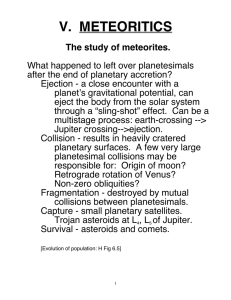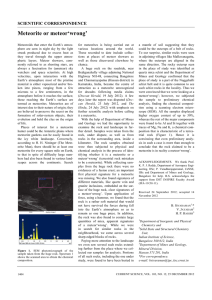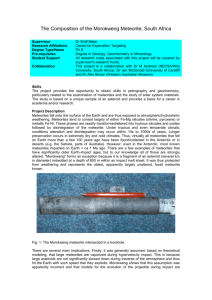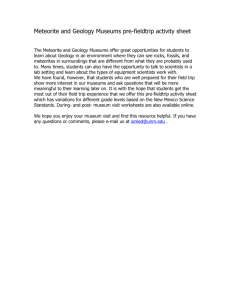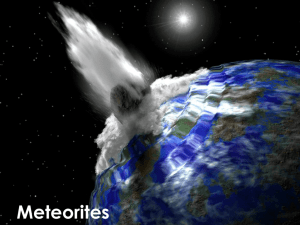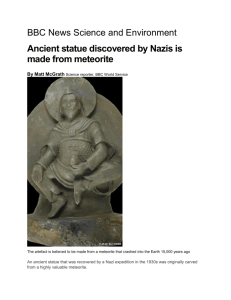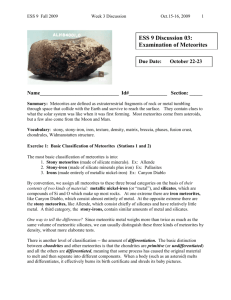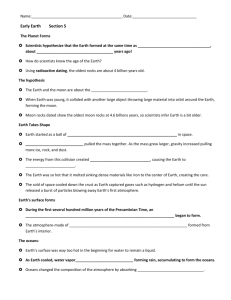Birth of the Earth - Geology for Today
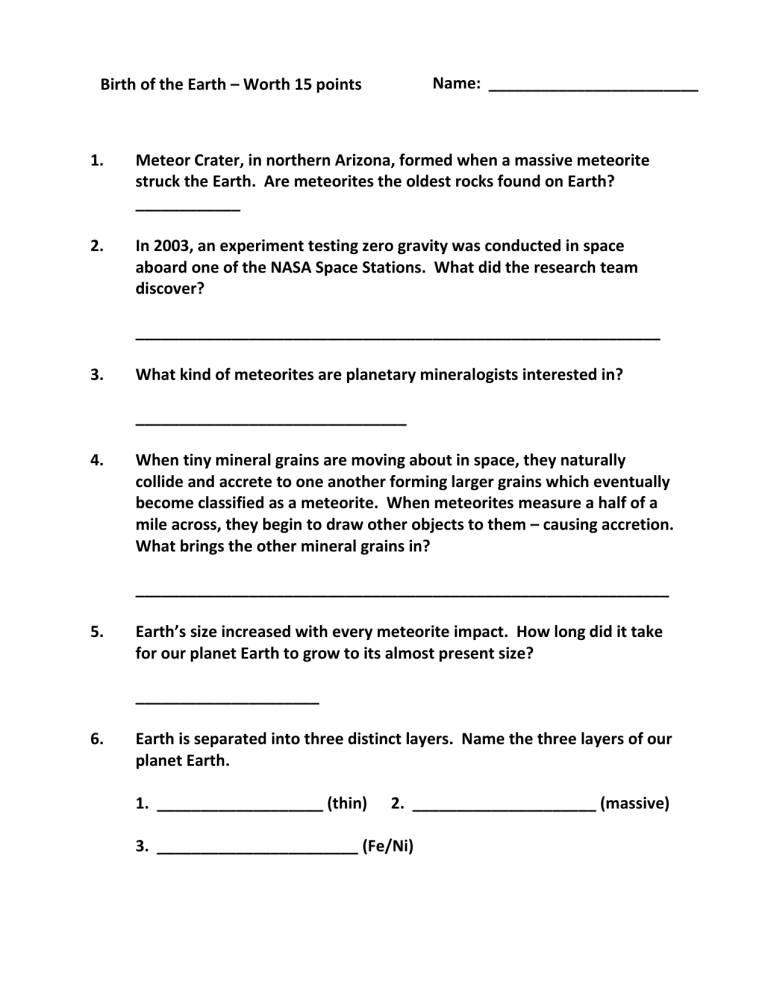
Birth of the Earth – Worth 15 points Name: ________________________
1. Meteor Crater, in northern Arizona, formed when a massive meteorite struck the Earth. Are meteorites the oldest rocks found on Earth?
____________
2. In 2003, an experiment testing zero gravity was conducted in space aboard one of the NASA Space Stations. What did the research team discover?
____________________________________________________________
3. What kind of meteorites are planetary mineralogists interested in?
_______________________________
4. When tiny mineral grains are moving about in space, they naturally collide and accrete to one another forming larger grains which eventually become classified as a meteorite. When meteorites measure a half of a mile across, they begin to draw other objects to them – causing accretion.
What brings the other mineral grains in?
_____________________________________________________________
5. Earth’s size increased with every meteorite impact. How long did it take for our planet Earth to grow to its almost present size?
_____________________
6. Earth is separated into three distinct layers. Name the three layers of our planet Earth.
1. ___________________ (thin) 2. _____________________ (massive)
3. _______________________ (Fe/Ni)
7. After the Earth formed and began melting, the denser elements sunk to the innermost layer, the core. What caused the heat?
_____________________________________________________________
8. During the earliest stages of the formation of Earth, molten magma oceans surrounded the planet with no continents (land). Surface temperatures on Earth were how hot?
_______________________
9. The surface rock could not stay molten forever and began to cool. In less than a __________________, the Earth cooled with a thin crust. Lava continued to pour out onto the surface and meteorites continued to bombard the Earth.
10. In 1650, Arch Bishop James Usher studied the book of Genesis (Bible) and traced the lineages of the prophets and kings. From his studies, he claimed that the Earth was formed during the nightfall before Sunday.
What month, day, and year did Usher believe the Earth was made?
_____________________________
11. In 1897, a physicists named Ernest Rutherford conducted experiments with radioactive decay. However, he found that the earliest stages in
Earth’s history were very hard to find. Why is this?
___________________________________________________________
12. In the 1950s, an American geologist named C. C. Patterson tried a new approach by studying meteorites. Patterson believed that if he could get an accurate date from radioactive decay, he could determine the approximate age of the Earth. What did he discover?
___________________________________________________________
13. The meteorite that struck Meteor Crater, Arizona measured _______ yards a across.
14. The meteorite slammed into the Earth at a fantastic speed. How fast was it moving through the Earth’s atmosphere? _________________
15. The force of the explosion was determined to be approximately
_______________ of an atomic bomb.
16. Is iron magnetic? _____________
17. Through modern radioactive dating, what is the proposed exact age of the
Earth?
______________________________________
18. In 1974, a radical new theory emerged. What origin was Bill Hartman concerned about?
______________________________________
19. A large impact of the Earth suggested that a planet about the size of Mars crashed into it. Hartman claimed that the debris from the collision formed the Moon. Collected from the Moon itself in April of 1972, the
Apollo 16 Mission brought back a rock approximately 20 lbs. Where is the
Moon rock kept? ______________________________
20. What mineral(s) was the Moon lacking or showing less than the Earth?
__________________
21. What was the Moon rock composed of that indicates it came from the
Earth? ____________________________________________________
22. What happened to the other planet? Where is it?
__________________________________________________________
23. Did the other planet hit Earth head on? _________
24. Is Hartman’s Moon Impact Theory readily accepted today? ________
25. In the northeast shore of Hudson Bay, Canada (Porpoise Cove), Jonathan
O’Neil has studied a small area with bizarre altered volcanic rocks called amphibolites. Exactly how old were the rocks showing from the radioactive dating? ________________
26. Amphibolites form at very high temperatures deep within the Earth. In fact, they form deep under water near continents. With all consideration, is there evidence that Earth had already formed landmasses approximately 4.3 billion years ago? ___________
What thickness was proposed for the Earth’s landmasses during this time? _________________________________
27. Altered layers of silica and magnetite are found not too far from the
Porpoise Cove region. What is the name given to these formations?
________________________________
28. Do these formations have connection with land masses or oceans?
___________________
29. In 1998, a meteorite fell to the Earth. The rocks were analyzed, and were found to contain grains of table salt. Minute droplets of water with preserved in inclusions within the rock.
What was the age of the water? ___________________________
30. Does the age of the water droplets reflect the age of our solar system?
__________________
31. As the meteorites fell to the Earth, drop after drops of water hit the surface of the earth. How long did it take for the water (oceans) to fill up their present volume? __________________
32. Without ____________ which are preserved in sedimentary rocks such as chalk and limestone, no coal, gas or oil would be present on Earth.
33. On the desert landscape of Allende, Northern Mexico on February 8, 1969 at 1:00 a.m. a large fireball was seen in the sky. With it, a very large meteorite about the size of a car plunged through the atmosphere. Was their a crater left behind? ______________________________
34. Some stones were found. One, as large as a beach ball was found in the region. Scientists were able to determine that the meteorite was traveling from south to north at _______________ miles per hour.
35. Samples from Allende, Mexico were analyzed and to the scientist’s surprise, what did they find preserved in the meteorite?
____________________
36. The building blocks of Life came from ___________.
37. Approximately 3.5 billion years ago, new forms of life sprung. Life needs oxygen. During this time the atmosphere contained deadly poisonous gases. Primitive life forms did not exist.
However, during this time, one type of unique organism left mounds composed of the mineral calcite called ________________________.
38. Dr. Janet Seifert studies these rock formations and feels that they are a type of proxy that happened right before the Earth’s atmosphere had a lot of oxygen in it. These stromatolite formations are dominated by billions of microbes called ___________________ which produce oxygen.
39. Tiny _____ ___________ occur when oxygen is released from the cyanobacteria that live on and within the stromatolites.
Copyright 2014: Geology for Today – geology4today.com. All rights reserved.
